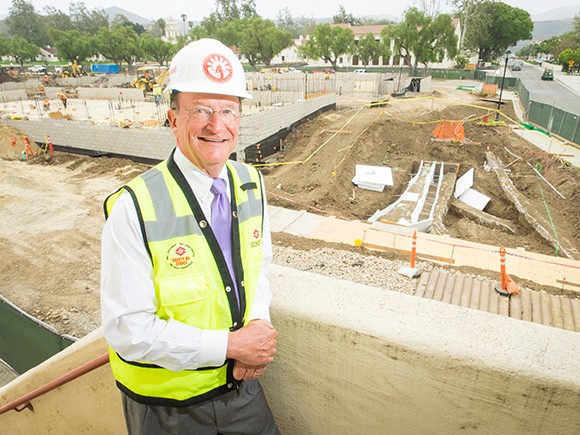Channeling a bold idea: CSUCI embarks on $600M build-out
IN THIS ARTICLE
- East Ventura County Topic
- Marlize van Romburgh Author
By Marlize van Romburgh Friday, June 13th, 2014

CSU Channel Island President Richard Rush stands near construction of a new chemistry lab building on the campus. CSUCI has embarked on a $600 million campus build-out. (Nik Blaskovich / Business Times photo)
With the state of California’s higher education budget in disarray, CSU Channel Islands President Richard Rush has turned to the private sector to complete the dream of a four-year public university to serve Ventura County.
The university is embarking on a $600 million build-out of the Camarillo campus over the next decade, with much of the funding coming from on-campus housing. CSUCI 2025, as the plan is named, calls for the university to triple its full-time enrollment to 15,000 students.
“When I was hired, I was given a mandate from Day 1,” said Rush, who was the founding president when CSUCI opened in 2002. “That was to find private support to build out CSU Channel Islands.”
Along with constructing new academic buildings, the university is moving forward with plans to develop on-campus housing for faculty and students. The apartments and single-family homes provide a source of revenue for CSUCI as well as a campus residential community.
CSUCI is the newest school in the 23-school California State University system. It was built on the grounds of a former state mental hospital nestled between the strawberry fields of rural Camarillo. Having 15,000 students and 1,500 faculty on campus has been the dream from the get-go, but stagnant state funding and the recession forced the university to shelve its long-term plans for years.
Still, in its first decade, the university doubled in size to more than 1,200 acres and developed more than $230 million in building and renovation projects.
State funding has momentarily caught up, Rush said, and the university plans to grow enrollment by 8 percent year-over-year. CSUCI has engaged a private development consultant in the bid to finally build out the school, and the university is kicking off construction of an event center, new science building and a secondary entrance to campus.
After that, it will develop a conference and recreation center, expand parking and build out hundreds of units of new student housing. Existing on-campus single-family homes for faculty and for-rent student apartments are almost fully occupied, Rush noted.
Because Ventura County’s Save Our Agricultural Resources initiative limits development on farmland, no student housing has been built around the university, and the school remains largely a commuter campus. “We’re desperate for housing,” said Rush.
As of fall 2014, the university had 5,144 students. Rush said the state has promised to provide enough funding next year to add an additional 600.
For the 2014-15 school year, California has proposed a $142.2 million bump in the CSU system’s budget, money that would go to enrolling additional students and hiring more full-time faculty as student applications hit record highs. CSU Chancellor Timothy White is lobbying to get an additional $95 million for the CSU system to add another 20,000 students across the network of universities.
For CSUCI, that means finally moving toward becoming a four-year university similar in size to Cal Poly in San Luis Obispo, where President Jeffrey Armstrong is also embarking on plans for building thousands of units of on-campus housing over the next decade. Both presidents have said that housing the majority of students in residential communities on campus provides a better learning environment and fewer clashes with neighbors.
The Camarillo university has been one of the few campuses in the CSU system to expand its student body during and after the Great Recession as higher-education officials worked to fill out the young campus.
“It’s actually stunning to see [CSUCI]‘s transformation. To see what’s happened in 10 years … it may seem like a glacial pace to the outside world, but for higher education, 10 years is quite remarkable,” CSU Chancellor Timothy White said in a talk at the Camarillo campus last year. “This will be one of the jewels of the Cal State system. There’s no doubt in my mind.”
California taxpayers subsidize the cost of education at state universities. Along with student tuition, the third pillar financing the CSU system is private support. White has said he’d like to see the business community, which hires heavily from public universities in the state, step up to partner with California higher education in a larger way.
“If we wait [for the public to pay for the university], that will never happen … We need to harvest this relationship and engage in public-private relationship,” he said. “It can’t be state-only, student-only.”










